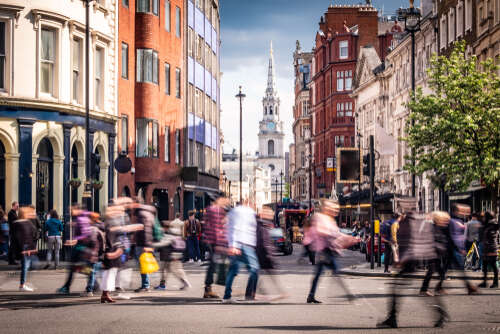
Every day our crowded public transport network accommodates not only millions of people but also the varied fabric of our lives – from luggage to gym bags, pushchairs to tool kits. Technology-enabled personal mobility – from Uber to home deliveries – has put even more vehicles on the road. The welcome and much-needed uptick in cycling adds another layer to the mix.

Our daily frustrations are regularly aired: from aggressive driving to phone zombies; pedestrians in bike lanes, to bikes cutting lights. Tube riders who won’t make space, loud telephone conversations or music percolating from earphones… We all have our lists.
Cities are complex ecosystems that work, in part, through a series of unspoken codes, negotiation and accommodation. If everyone is to have a place in the city, for us to move safely and in harmony, it’s time to look afresh at how we support and guide people on the rules, their rights, and responsibilities on London’s roads and streets.
When the motorcar first traversed our streets, someone walked ahead waving a red flag, to warn pedestrians. As cars became ubiquitous, we created the Highway Code, which focused on the ‘rules of the road’.
Over the intervening decades our city, priorities, transportation choices and population have changed enormously. Increasing numbers of people now eschew driving altogether, so fewer Londoners actually know the Highway Code. This means we are moving around our busy city with different needs, assumptions and knowledge. And though the Highway Code has been updated, it has not kept up with the pace of change.
We need a ‘new movement code’ – a new platform for sharing our city, based on how we live and travel now. Much more than a cycling or a pedestrian campaign, it would offer a refreshed and fit-for-purpose protocol, information and behavioural campaign, designed to better guide the daily interaction between different users.
Highway Code is not fit for purpose
It could embrace trip planning tools and road user training, and may well need to lead to changes in the official rules if the current ones prove wanting in the face of societal change. But for now, it simply surfaces what exists already, overlaid with a voluntary guide. At its most basic, it should help people understand what we can legally expect of each other as we go about our daily lives.
Mark Twain reminded us that we are not making any more land. Yet we are building more homes, workspace, bike lanes, widened pavements, and adding more people in a space-constrained city. If our city is to accommodate that pressure it needs help, from us.
It’s worth remembering, though, just how far we’ve come since the days when Trafalgar Square was a traffic-clogged roundabout. When few traffic lights had pedestrian walk times, dropped kerbs were the exception and public space was lined by tracts of ugly guardrails. We’ve unravelled one-way systems, prioritised good design, pedestrianised streets and softened urban edges with planting and public art. We made London more liveable, easier to walk, and much more pleasant to linger and soak in the city.
But we can’t just rely on the built environment to change and inform our travel habits. A new movement code would be based on mutual understanding, common courtesy and respect. It would be known and used by all road users, of all ages and abilities.
Through generosity and empathy for our fellow Londoners, we can all help make this amazing city, and its busy streets and spaces, work for everyone.
[Read more: Tubes, bridges & sewers: The centuries-old infrastructure Londoners still use today]






